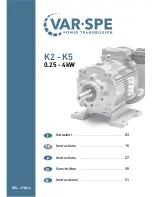
© 06/2020 ECHO Incorporated X7152270100
21
QUICK START GUIDE / GUÍA DE INICIO RÁPIDO / GUIDE DE DÉMARRAGE
RAPIDE
PAS-225 / PAS-2620
Pro Attachment Series
™
Utiliser uniquement une vitesse réduite pour effectuer les taches légères
ou pour respecter les réglementation locales relatives au bruit. Un
fonctionnement continu à basse vitesse risque de favoriser les dépôts
de résidus d’essence/huile sur le piston et un calaminage rapide du
pare-étincelles, entraînant la surchauffe et l’endommagement du moteur.
Pour limiter les dépôts nuisibles, faire tourner le moteur à plein régime
pendant au moins 5 minutes toutes les heures, et inspecter/nettoyer le
pare-étincelles au bout de 40 heures de fonctionnement.
Pour éviter des dommages au moteur causés par un surrégime, ne pas
bloquer le tube de soufflante.
1. N’utiliser qu’aux heures permises.
2. Laisser le moteur se réchauffer au ralenti pendant quelques minutes.
3. Utiliser une inférieure pour souffler des débris des surfaces dures.
4. La vitesse additionnelle peut être nécessaire pour essuyer les débris, la
neige, etc. des pelouses et les lits de fleur.
Remarque: Ne jamais utiliser une vitesse supérieure à ce qui est nécessaire
pour un travail donné. Ne pas oublier que plus le régime est élevé,
plus le moteur est bruyant. Minimaliser la poussière en travaillant à
bas régime. Ne pas chasser les débris sur la propriété d’autrui. Soyez
intelligent – Montrezvous bon voisin.
MAINTENANCE PROCEDURES
Idle Speed Adjustment
Idle Speed Adjustment
Every unit is run at the factory and the carburetor is set in compliance
with emission regulations. Carburetor adjustments, other than idle
speed, must be performed by an authorized ECHO dealer.
1. If a tachometer is available, idle speed
screw should be set to 3000 RPM. Turn
idle screw clockwise to increase idle
speed; counterclockwise to decrease idle
speed. If a tachometer is not available,
see your authorized ECHO dealer.
Replace Nylon Line:
Speed Feed™
1. Cut one piece of 2.0 mm (0.80 in.) or 2.4 mm (0.95 in.) line to
recommended length of 6 m (20 ft.).
2. Align arrows on top of knob with opening
of eyelets.
3. Insert one end of trimmer line into eyelet
and push line until equal lengths extend
from trimmer head.
4. Hold trimmer head while turning knob
clockwise to wind line onto spool until
about 13 cm (5 in.) of each line remains
exposed.
+
_
3000 RPM \ TR/MIN
Sharpening 8-Tooth Metal Blade
Several styles of metal blades are approved for
use on the Brushcutter. Only the 8-tooth blade
can be sharpened during normal maintenance.
The clearing and 80-tooth blades require professional
service for sharpening
.
Before sharpening, CLOSELY inspect blade for
cracks (look at the bottom of each tooth and
the center mounting hole closely), missing teeth
and bending. If ANY of these problems are
discovered, replace the blade.
When sharpening a blade, always remove the
same amount of materials from each tooth to
maintain balance. A blade that is not balanced will cause unsafe handling due
to vibration and can result in blade failure.
1. File each tooth at a 30° angle a specific
number of times, e.g., four strokes per
tooth. Work your way around the blade until
all teeth are sharp.
2. DO NOT file the ‘gullet’ (radius) of the tooth
with the flat file. The radius must remain. A
sharp corner will lead to a crack and blade
failure.
30º
30º
If an electric grinder is used,
use care not to overheat teeth,
do not allow tips/tooth to glow
red or turn blue. DO NOT place
blade in cooling water. This
will change the temper of the
blade and could result in blade
failure.
3. After sharpening teeth, check
each tooth radius for evidence
of a square (sharp) corner. Use
the round (rat tail) file to renew
the radius.
Edger Blade Replacement
Parts required: Blade, new split pin.
Note: Replace blade when it is
bent, damaged, or worn
shorter than 152.4 mm (6
in.).
1. Remove split pin (A).
2. Align hole in inner blade
adapter (B) with notch in gear
housing, and insert locking tool
(G) to prevent PTO shaft (C)
from rotating.
3. Remove L.H. blade nut (D) by
turning clockwise. Remove
outer blade adapter (E), and
blade (F).
4. Install and center blade (F) on
inner blade adapter (B).
5. Install outer adapter (E) and
nut (D). Tighten nut (D) firmly,
turning counterclockwise.
Note: Never reuse old split pin.
6. Install new split pin (A) to
secure nut, and bend both legs
of pin counterclockwise around
PTO shaft (C).
30º
Cutting Tooth Area /
Área de corte de dientes /
Zone de dent de coupe
Gullet Radius /
Radio de oro /
Rayon d'or
Cutting Tooth Radius /
Radio de diente de corte /
Rayon de dent de coupe
G
B
D
E
A
F
B
C








































